Altstadt.Origins
were possibly rooted in either the current area of Altenstädt, Hessen, in the 10th Century or Altstätten, Switzerland as early as the 13th Century - migration occurred in the 14th century to upper Baden-Württemberg and lower Hessen and into Austria.
In the 17th Century, after the 30 years war, immigration from Switzerland and Austria continued into the Baden and the Fränkische-Schweiz area of Bavaria
Allstädt Origins
were possibly rooted west of Halle in Saxony-Anhalt around the 12th Century
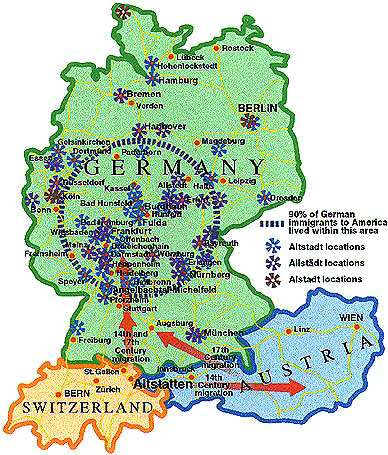
Researcher Suspects Five Original Altstadt Tree Root Systems and Is Looking to Get to the Bottom of How All the Altstadt Lines Fit!
Hermann Altstatt of Erlangen, Germany, is tracing all the possibilities of finding the origins of the roots of our Allstädt/Alstadt/Altenstadt/Altstadt lines and their historical beginnings in Germany and Switzerland
He believes that we can cluster the whole (Allstädt/Altstadt) Clans into five groups:
1. Altstadt - Originally from central Hesse: Burghaun (Clausmarbach), Schwalmstadt, Schlitz , Haunetal, Hünfeld, Bad Hersfeld
........• 1659, Reinhard Altstadt (or Altenstadt) in Clausmarbach
........• ca. 1400 Herr v. Altenstadt in Marburg/Rauschenberg
2. Altstadt - Originally from Michelfeld Area: Angelbachtal, Badenweiler, Müllheim, Erlangen, Gelsenkirchen, Bad Salzungen, Kraichgau, Heilbronn, Mühlhausen, Kenzingen, Bad Schönborn
........• 1756, Georg (Reinhard?) Altstadt in Michelfeld
3. Altstadt - Originally from Frankfurt Area: Frankfurt, Dreieich, Hanau, Ulm, Neu-Isenburg, Oberursel
........• 1673, Johann Caspar Altstadt in Hain/Dreieichenhain
........• 1637, First Altstadt was born and recorded in the Lutheran Church of Darmstadt
4. Altstädt-Allstädt-Allstedt - Originally from Westphalia: Dortmund, Hagen, Essen, Dormagen, Mühlheim, Halle, Witten, Castrop-Rauxel
........• 1588, Johannn Heinrich Alsted (Altstetten) in Ballersbach
........• 1145, Dietrich II v. Altstätten
5. Altstadt - Originally from Prussia: Berlin, Hohenlockstedt, Hamburg, Bremerhafen, Amberg, Schleswig, Flensburg, Priesendorf, Himbergen, Leer
........• 1560 Hermann Werner Altstedt (Alstedt, Ahlstedt, Altstedt) and
........• 1588 Hermann Alstede (son of Hermann Werner) in Lübeck
.......This family, went to Sweden and East Prussia as ministers (Lutheran); the spelling in Prussia was “Altstadt” or .......“Altstadius”
........•ca. 1200, Johann V. Allstedt (Alstedt)
In the northern and northwestern part of Germany they used the ending ..stedt, ..städt ..stede or stedius (latin) and in the southern and eastern part they used ..stadt or stadius
Altstadt Origins
Family genealogist, Hermann Altstadt, has pursued old documents and is almost certain that the earliest known Altstadt origins center around Altenstâdt, Hessen, as early as the 9th Century AD. In olden times the town of Altenstädt was called Alahstat. The castle of Altenstädt in these days is called Weidelsburg Schloss. The first earl of Alstat Castle was Meginfried von Alstat, Stammtafel der Grafen von Naumburg.
Before the 12th century, the European population had only first names and no surname. Also, suppositions of the ethnic background of the Altstadt families has no known foundation. Churches began recording baptisms, marriages and burials in the 1500s. Due to the destruction of churches and records during the Thirty Years' War in the 17th century, it is virtually impossible to trace the Allstädt/Alstadt/Altstadt family trees back further than the mid-1600s..
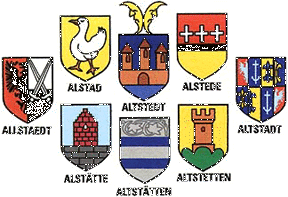

Allstädt/Altstadt Roots
Ewald Wuschke, an Altstadt family researcher, has probably located our original clans. According to
Ewald, one clan of Altstatts relocated to the Frankfurt au Main river area of Germany in the 14th century A.D. from the area of the 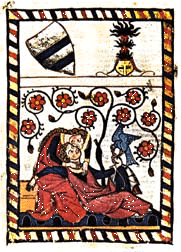 town of Altstätten, Switzerland, which is located about ten miles from St. Gallen on the shores of Lake Constance. The bosses of Altstätten at that time were the von Altstättens who founded the town in 1272. A prominent figure of that line was Konrad von Alstetten (note Alstetten shield in the illumination to the left). Konrad was a meistersinger and a bürger (mayor) of the town of Altstätten in the 1320s. Research is now underway to trace movements of this Alstetten into the area of lower Hessen and upper Baden-Württemberg. Another branch of this Alstetten line is suspected to have immigrated into Austria and later settled in an area around Augsburg, Germany, in the 17th century. It is thought that The Allstaedt/Altstaedt Clan, or Allstädt/Altstädt families, presumably originated from the town and castle of Allstedt in Saxony-Anhalt. This family was already quite prominent in the 10th century under Otto the Great. The town lies today in the district of Halle. Prominent in the 12th century was Heinrich von Gleißberg und Allstedt. The Alstad-Alstadt line has been placed in the area of Mainz, Germany in the 15th century and a Hans Alstadt was a magistrate in the town of Aschaffenburg between 1416 and 1426. Heinrich Alstedius was a
town of Altstätten, Switzerland, which is located about ten miles from St. Gallen on the shores of Lake Constance. The bosses of Altstätten at that time were the von Altstättens who founded the town in 1272. A prominent figure of that line was Konrad von Alstetten (note Alstetten shield in the illumination to the left). Konrad was a meistersinger and a bürger (mayor) of the town of Altstätten in the 1320s. Research is now underway to trace movements of this Alstetten into the area of lower Hessen and upper Baden-Württemberg. Another branch of this Alstetten line is suspected to have immigrated into Austria and later settled in an area around Augsburg, Germany, in the 17th century. It is thought that The Allstaedt/Altstaedt Clan, or Allstädt/Altstädt families, presumably originated from the town and castle of Allstedt in Saxony-Anhalt. This family was already quite prominent in the 10th century under Otto the Great. The town lies today in the district of Halle. Prominent in the 12th century was Heinrich von Gleißberg und Allstedt. The Alstad-Alstadt line has been placed in the area of Mainz, Germany in the 15th century and a Hans Alstadt was a magistrate in the town of Aschaffenburg between 1416 and 1426. Heinrich Alstedius was a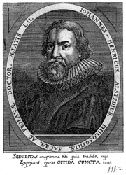 prominent philosopher who taught at the University of Marburg in the 16th century and wrote the first Germany encyclopedia. Heinrich died in Romania.
prominent philosopher who taught at the University of Marburg in the 16th century and wrote the first Germany encyclopedia. Heinrich died in Romania.
Ancient Europe
First identifiable as a linguistic group about 700 - 600 B.C. in the west Baltic area of Scania, Bornholm Gothland and north Germany between the Rhine and Oder Rivers, the Germans spread slowly southward, helped on, perhaps, by the wetter and cooler conditions of the sub-Atlantic period from 500 B.C. or thereabouts. By 200 B.C. they had reached the river Main and by 114 B.C. they had appeared on the Italian frontiers of Rome. From then on, their culture and economy had been gradually affected by their contacts with the Roman Empire, particularly on or near the frontier regions.
.....As Germany emerged as a political state in the Middle Ages, it was composed of three distinctive regions and cultures. Latin Germany, the area along the left bank of the Rhine, was conquered by the Romans in the 1st century B.C. Teutonic Germany, the region lying roughly between the Rhine and the Elbe Rivers, was the home of the Germanic tribes never subdued by Roman military might. Indeed, as the Roman Empire gradually declined, Germans began to enter its borders in growing numbers. Following the Roman state's disintegration, a vast Germanic Empire arose between the 5th and 9th centuries A.D., extending over much of western and central Europe. The third component of the nation was Slavic Germany, the land stretching from the Elbe Eastward to the Oder, Vistula and Memel Rivers. The Germanization of this territory was the result of a long period of peaceful settlement as well as military conquest between the 12th and 14th centuries A.D.
.....The Franks, a Germanic tribe from the Rhine valley, under Clovis (481-511) acquired most of Gaul and consolidated a hold on most of western Germany. One of Clovis' greatest successors was Charlemagne, who defeated the tribes along the Elbe River and Christianized them. His conversion to Christianity brought the involvement of German rulers into papal affairs. His empire covered most of modern France and Germany. In 800 A.D. he was crowned Emperor of the Holy Roman Empire. Aftrer the death of Charlemagne, his dynasty weakened and ended in 911.
.....Different German districts then began to choose rulers from among themselves but these rulers still owed allegiance to the Holy Roman Emperor.
.....The Age of the Reformation intensified political disunity in Germany. By the 16th century it was probably too late to halt the decline of imperial authority, moreover, the Reformation did much to hasten the process. While the Hapsburgs, the elected Emperor line since 1273, remained loyal to the Pope, many territorial princes asserted their independence by embracing Protestantism. Only when the great voyages of exploration had shifted westward to the Atlantic did the financial decline of Germany begin, followed by the exhaustion of artistic vitality.
.....
Struggle, between Catholic and Protestant finally ended in the Treaty of Westphalia in 1648, with the country divided into hundreds of territorial units and the economy in shambies.
The Dark Haired Germans
Studies of history revealed the characteristic person of the Teutonic race as having blond hair. Why then do the clans lean toward dark hair and blue eyes? This trait we owe to the Romans. In the days of the Roman Empire, the great Caesars were never able to conquer the lands across the Rhine River. In order to keep the barbarians out of Roman territorly they constructed a great wall, similar to what the Chinese built in their part of the world. Hadrian's wall ran across the top of conquered England; then another wall, constructed on the European continent, ran from present day Holland, down the south bank of the Rhine River into the Rhine Valley, and across the Danube Basin. To further keep the barbarians from killing Romans along the frontier, they imported conquered Syrians/Armenians and relocated thern along the borders north of Italy which were in conflict with Germania. These assimilated Syrians/Armenians eventually picked up the language of the Rhine River area which was Germanic in tongue This area is known today as northern Switzerland and southern Germany
Spelling and meaning of the Allstadt - Altstadt Family Names
An important document researched by Hermann Altstadt gives a "revolutionary" meaning of the surname "Altstadt" and its variances and maybe a further root of (von) Alstat (Alsted, Aldenstad...) links the name to Aschaffenburg, Mainz, Central Hessia and with Burghaun. The name Alahstat may have been born by places where a heathen temple, a hallowed place of justice, or a house of the king stood. For, not only the fanum, but the folk-mote, and the royal residence were regarded as consecrated, or, in the language of the Middle Ages, as frôno (set apart to the frô, lord). Alstidi, a king's pfalz (palatium) in Thuringia often mentioned in Dietmar of Merseburg, was in OHG. Alahsteti, nom. "alahstat."
"Alt..." in olden times did not mean old!!! "Alt..." or in "althochdeutsch" (Old High German; OHG) was "alah..." or in "mittelhochdeutsch" (Middle High German; MHG) was "ale..."" and gotisch (Gothic) was "alhs...". Thus, Alahstat means Aldenstede-Alstet-Alstat-Altenstädt-Altenstadt-Altstadt...Allstadt in the German language today means "Universal Town." While Altstadt and Altstatt both translate "Old Town." Another old surname, Altenstädt, means "Old Place." Feudal Europe of the Middle Ages was made up of hamlets or 'Villas' where the serfs or peasants lived. Because these peasants lived in 'villas' or 'villes' they were called 'villiens'. Villien is the medieval word for peasant. So, the name Altstatt, in its medieval sense could also mean "Old Peasant." Until the early 19th century, when word spelling became standardized, clerics in Germany wrote phoenetically, thus spelling a sumame the way they felt they heard it. Ancient spellings that can be linked to the Allstadt/Altstadt clans are: Altenstadt, Altenstedt, Altstetten, Alstadt, Alstedt, Alsted, Allstedt and Altsted. In addition, various "Americanizations" of Altstadt and Allstadt have been made over the last two centuries in many of the American clan branches.
..... No connection has been found between the root surnames of Allstadt and Altstadt, but the great majority of the clans, bearing either of those names, who immigrated to America, came from either Hessen or states that bordered that German state. This is not to say that the Allstadt/Altstadt families come from one ancestor. The suggestion is that back in antiquity, there could probably have been a connection but that 'missing link', if there was one, will probably never be found.
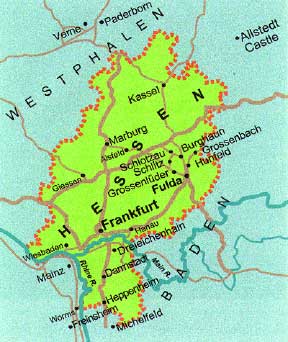
90% of the Allstadt/Altstadt Immigrants to America had family origins in the German State of Hessen
.... Johann (Hans) Martin Altstatt, was the oldest son of Johann Caspar Altstadt. Martin's family landed at
Philadelphia, Pennsylvania, on August 19, 1729, and is the earliest known immigrant member of the American clans to have set foot in America. On September 24, 1760, Martin and his son, Nicholas, became naturalized British citizens at Philadelphia. Martin's surname has been found "Anglicanized" on legal documents from Altstatt to the spelling of Alstott by the British colonial government . Other surname spellings used by later descendants of Martin Altstatt were Aldstadt, Allstadt, Allstatt, Allstot, Allstott, Alstadt, Alstatt, Alstot and Alstott.
.....Adam and Rhinehart Alstadt were brothers who immigrated in 1837 to Gibson County, Indiana. Their naturalization papers, on file in Indiana, state that ''they came to the United States from Heppenheim, Darmstadt, Hessen." Martin Altstatt hailed from Dreieichenhein, Hessen, only around 18 miles (30 km) to the north of Darmstadt. No known Altstadt or Altstatt immigrant to America is known to have taken up roots and reared families between the immigration of these three families. A Johann Michael Alstatt who arrived on the ship Brittiana on October 26, 1767, at Philadelphia was researched by Charles Otstot and he relates that, "The writing on the passenger list is very poor and I have doubts if this is, in fact, an Alstatt at all.". That brings the conclusion then: that any Altstadt born in America, before the 1837 immigration of Adam and Rhinehart Alstadt to the United States has to be a descendant of the immigrant, Martin Altstatt. Spellings used by later descendants of Adam and Rhinehart are Alstadt and Alstat.
..... Of the Allstadts, Allstaedts, Altstadts and Altstatts immigrating to America in the 1830s through 1939 who listed their place of residence in Germany, it has been found that most of these lines came from within a 90 mile (150 km) radius of Fulda, Hessen, Germany.
..... Migrations by the clans were not limited to America, for research has found Altstadts, originally from Germany, settling in Poland, Russia and Scandinavia during the last half of the 17th and early parts of the 18th century. Many of these resettled again to both Canada and the United States in the 19th Century. In fact, known Altstadts resettled to Argentina and Sweden just before WWII, in order to stay out of the military draft and are still living in those areas today.
Back to Charts



 town of Altstätten, Switzerland, which is located about ten miles from St. Gallen on the shores of Lake Constance. The bosses of Altstätten at that time were the von Altstättens who founded the town in 1272. A prominent figure of that line was Konrad von Alstetten (note Alstetten shield in the illumination to the left). Konrad was a meistersinger and a bürger (mayor) of the town of Altstätten in the 1320s. Research is now underway to trace movements of this Alstetten into the area of lower Hessen and upper Baden-Württemberg. Another branch of this Alstetten line is suspected to have immigrated into Austria and later settled in an area around Augsburg, Germany, in the 17th century. It is thought that The Allstaedt/Altstaedt Clan, or Allstädt/Altstädt families, presumably originated from the town and castle of Allstedt in Saxony-Anhalt. This family was already quite prominent in the 10th century under Otto the Great. The town lies today in the district of Halle. Prominent in the 12th century was Heinrich von Gleißberg und Allstedt. The Alstad-Alstadt line has been placed in the area of Mainz, Germany in the 15th century and a Hans Alstadt was a magistrate in the town of Aschaffenburg between 1416 and 1426. Heinrich Alstedius was a
town of Altstätten, Switzerland, which is located about ten miles from St. Gallen on the shores of Lake Constance. The bosses of Altstätten at that time were the von Altstättens who founded the town in 1272. A prominent figure of that line was Konrad von Alstetten (note Alstetten shield in the illumination to the left). Konrad was a meistersinger and a bürger (mayor) of the town of Altstätten in the 1320s. Research is now underway to trace movements of this Alstetten into the area of lower Hessen and upper Baden-Württemberg. Another branch of this Alstetten line is suspected to have immigrated into Austria and later settled in an area around Augsburg, Germany, in the 17th century. It is thought that The Allstaedt/Altstaedt Clan, or Allstädt/Altstädt families, presumably originated from the town and castle of Allstedt in Saxony-Anhalt. This family was already quite prominent in the 10th century under Otto the Great. The town lies today in the district of Halle. Prominent in the 12th century was Heinrich von Gleißberg und Allstedt. The Alstad-Alstadt line has been placed in the area of Mainz, Germany in the 15th century and a Hans Alstadt was a magistrate in the town of Aschaffenburg between 1416 and 1426. Heinrich Alstedius was a prominent philosopher who taught at the University of Marburg in the 16th century and wrote the first Germany encyclopedia. Heinrich died in Romania.
prominent philosopher who taught at the University of Marburg in the 16th century and wrote the first Germany encyclopedia. Heinrich died in Romania.